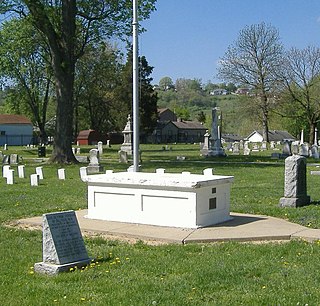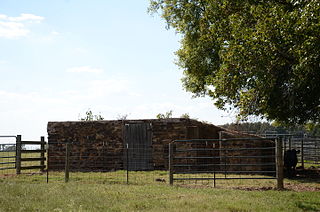
The Grand Army of the Republic Hall is an historic building located at 23 East Downer Place on Stolp Island in Aurora, Illinois, in the United States.

The Grand Army of the Republic Monument, in the Linden Grove Cemetery of Covington, Kentucky, was built in 1929 by the O. P. Sine of Garfield Post No. 2 of the Grand Army of the Republic, a group comprising the remaining veterans of the Union army.

The Franklin County G. A. R. Soldiers' Memorial Hall, also known simply as the Soldiers' Memorial Hall, is a historic building located in Hampton, Iowa, United States. The octagonal-style structure was designed and built in 1890 by Edward Carl Keifer. It was the meeting place of the J.W. McKenzie Post No. 81, Grand Army of the Republic (G.A.R.), which was one of 519 GAR posts in Iowa. The building is architecturally significant as it is one of the few examples of a Gothic Revival style structure of this type in the area. It is a memorial chapel that follows a cross-shaped plan capped by an octagonal cupola with a statue of a Union soldier on top. Its significance is also derived from it being the first G.A.R. Memorial Hall built in Iowa. The Iowa legislature had passed a law in 1884 that allowed counties to levy a tax to support building G.A.R. memorials. Captain Rufus S. Benson, a local state representative, had the law amended in 1886 so that it allowed for the construction of a memorial hall, as the local G.A.R. chapter wanted it to be a place where they could meet.

Arkansas Highway 385 is a designation for two state highways in White County, Arkansas. The southern segment of 8.98 miles (14.45 km) runs from Griffithville to Kensett. A northern segment of 6.23 miles (10.03 km) runs from Highway 367 in Judsonia to Plainview.
Grand Army of the Republic Memorial may refer to:

The George Gordon Meade Memorial, also known as the Meade Memorial or Major General George Gordon Meade, is a public artwork in Washington, D.C. honoring George Meade, a career military officer from Pennsylvania who is best known for defeating General Robert E. Lee at the Battle of Gettysburg. The monument is sited on the 300 block of Pennsylvania Avenue NW in front of the E. Barrett Prettyman United States Courthouse. It was originally located at Union Square, but was removed and placed in storage for fourteen years before being installed at its current location. The statue was sculpted by Charles Grafly, an educator and founder of the National Sculpture Society, and was a gift from the state of Pennsylvania. Prominent attendees at the dedication ceremony in 1927 included President Calvin Coolidge, Governor John Stuchell Fisher, Secretary of the Treasury Andrew W. Mellon, and Senator Simeon D. Fess.

The German-American Treue der Union Monument, is located in the Kendall County community of Comfort in the U.S. state of Texas. It was dedicated on August 10, 1866 to commemorate the German-Texans who died at the 1862 Nueces massacre. Thirty-four were killed, some executed after being taken prisoner, for refusing to sign loyalty oaths to the Confederacy. With the exception of those drowned in the Rio Grande, the remains of the murdered are buried at the site of the monument. This monument was the first authorized to fly the Star-Spangled Banner at half-mast in perpetuity. It was listed on the U.S. National Register of Historic Places in 1978.

The Soldier's Monument is a historic structure in the College Square Historic District in Davenport, Iowa, United States. The district was added to the National Register of Historic Places in 1983. The monument, which was built from 1880 to 1881, was individually listed on the Davenport Register of Historic Properties in 1993.

The Stephenson Grand Army of the Republic Memorial, also known as Dr. Benjamin F. Stephenson, is a public artwork in Washington, D.C. honoring Dr. Benjamin F. Stephenson, founder of the Grand Army of the Republic, a fraternal organization for Union veterans. The memorial is sited at Indiana Plaza, located at the intersection of 7th Street, Indiana Avenue, and Pennsylvania Avenue NW in the Penn Quarter neighborhood. The bronze figures were sculpted by J. Massey Rhind, a prominent 20th-century artist. Attendees at the 1909 dedication ceremony included President William Howard Taft, Senator William Warner, and hundreds of Union veterans.

The Star City Confederate Memorial is located at the southwest corner of the town square of Star City, Arkansas. The marble monument depicts a Confederate Army soldier standing in mid stride with his left foot forward. His hands hold the barrel of a rifle, whose butt rests on the monument base. The statue is about 6 feet (1.8 m) high and 2 feet (0.61 m) square; it rests on a marble foundation that is 20 feet (6.1 m) long, 12 feet (3.7 m) wide, and 8 feet (2.4 m) high. The monument was erected in 1926 by a local chapter of the United Daughters of the Confederacy at a cost of about $2,500.

The El Dorado Confederate Monument is located on the grounds of the Union County Courthouse in El Dorado, Arkansas, near the corner of North Main and South Washington Streets. It consists of a statue of a Confederate Army soldier in mid-stride, mounted on top of a temple-like structure supported by four cannon-shaped Ionic columns. The columns support a lintel structure bearing inscriptions on three sides, above which is a tiered roof with cannonballs at the corners. The temple structure is 15 feet (4.6 m) high, and 10 feet (3.0 m) square; the statue measures 76 inches (1.9 m) by 28 inches (0.71 m) by 28 inches (0.71 m). Both the statue and the temple are constructed of gray/blue striated marble.

The St. Charles Battle Monument is located at the center of the intersection of Broadway and Arkansas Street in the center of St. Charles, Arkansas. It commemorates the 1862 Battle of Saint Charles, a naval and land engagement of the American Civil War that took place just downriver from the city. It is a square granite monument, topped by an inverted cannon barrel. It is 18 feet (5.5 m) high and 9.5 feet (2.9 m) square. Its inscriptions commemorate the 148 Union soldiers who died in the explosion of the USS Mound City, caused by what is sometimes described as the single deadliest shot fired in the entire Civil War. Inscriptions on another side memorialize the smaller number of Confederate dead in the engagement. The monument was placed in 1919 through the efforts of a relative of William Hickman Harte, the master on board the Mound City who died in the explosion, and is one of the few memorials placed in a Confederate state by a northerner in commemoration of both Union and Confederate war dead.

The Grand Army of the Republic Memorial is a monument in Twin Springs Park of Siloam Springs, Arkansas. Located in the southern part of the park, it consists of a concrete foundation, on which rest two tiers of granite slabs, laid horizontally. These are topped by a vertical granite column that has an onion form at the top. The sides of the horizontal slabs are rusticated, as are three sides of the column. The fourth side is engraved, from the top down, with an inverted five-point star labelled "GAR", then the words "IN GOD WE TRUST", then a Maltese cross engraved "WOMEN'S RELIEF CORPS 1833", then "ERECTED BY/CURTIS POST/1928", and finally a wreath topped by an eagle and crossed cannons, with "US" in the center surrounded by "PRESERVED BY THE GRACE OF GOD". The memorial was placed in 1928, and is the only known memorial statewide to mention the Grand Army's Women's Relief Corps.

The James W. Edie House is a historic house at Jackson and Washington Streets in Judsonia, Arkansas. It is a two-story wood-frame structure, with a side gable roof, weatherboard siding, and a stone pier foundation. A cross gable section projects from the center of the front facade, with a single-story porch spanning its width. It is supported by wooden columns with capitals at the top, and has decorative jigsawn balustrades and brackets. Built in 1883, it is one of White County's few surviving 19th-century houses.

The Judsonia Bridge is a historic bridge, carrying Van Buren Street across the Little Red River on the south side of Judsonia, Arkansas. It is a three-span metal truss swing bridge, with a total structure length of 397 feet (121 m). Its center span is 266 feet (81 m) long, and is mounted on a pivot on a central pier. It and the two approach trusses are all Warren trusses. Built in 1924, it is one of three known swing bridges in the state, and the only one with a cantilevered swinging truss. It was closed to traffic in 2007, and reopened in 2013 after restoration.

The Rock Building is a historic building in rural White County, Arkansas. It is located on the west side of Bartell Road, north of Judsonia and west of Arkansas Highway 13. It is a single-story stone structure, now lacking a roof, of uncertain original function. It was built about 1915, and originally had a gabled roof that extended over a porch. The building is unusual by virtue of its stone construction, which is rare for the period in the county.

The Winchester Soldiers' Monument is a historic war memorial located in a park-like setting at the end of Crown Street in the Winsted area of Winchester, Connecticut. Built in 1889–90, it commemorates the community's participants in the American Civil War. It is one of Connecticut's most architecturally elaborate memorials to that conflict. It was listed on the National Register of Historic Places in 1984.
The Gentry Grand Army of the Republic Memorial is an American Civil War monument in the northeast section of Gentry Cemetery in Gentry, Arkansas. It is a limestone structure with Classical Revival features, consisting of a stepped square base, a tier of marble panels framed by round columns, and a tapered obelisk topped by a carved capital and round knob. Two of the marble panels are inscribed with the names of soldiers who served in the Union Army. The monument was installed in 1918 through the efforts of David Kost, a Civil War veteran who organized Gentry's chapter of the Grand Army of the Republic (GAR). It is one of a relatively small number of GAR memorials in the state.


















